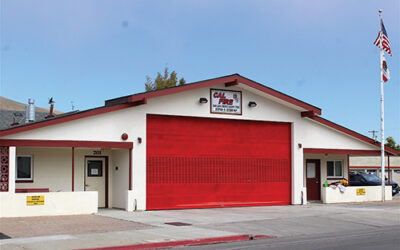The Morro Bay City Council voted to apply for a federal grant that could greatly reduce the City’s share of financing the new Water Reclamation Facility project that has now topped $138 million.
The Council voted to have the city manager apply for a U.S. Bureau of Land Management (BLM) grant under Federal Title XVI the “Water Infrastructure Improvements to the Nation Act” (WIIN).
Under the grant program’s guidelines and limitations the City could apply for up to $20 million — the maximum amount available — and the vote was to go for the max.
The City put together a full application package for the program that included details about the City’s WRF financing plan, which entails a $5 million State Water Resources Control Board planning grant; a $56.4 million low-interest loan (0.8317%) from the U.S. Environmental Protection Agency’s “Water Infrastructure and Financing Innovation Act” (WIFIA) Program; $57.3 million low-interest loan from the California State Revolving Fund (SRF) at 1.20% interest — to be used specifically for the wastewater financial component of the project; and, some $20 million in cash raised through the City’s WRF surcharge of $41 a month per water/sewer customer.
The idea is if the City can get the federal loan, it won’t have to use so much cash from the surcharges. However, whether or not that would lead to a drop in the surcharge for customers is unclear.
The WIIN amendment, enacted in December 2016 was to “address water resources infrastructure that is critical to the Nation’s economic growth, health, and competitiveness,” according to the City report.
This WIIN amendment to Title XVI allows any wastewater-recycling project to apply for funding, where as previously, only projects approved by Congress could be funded.
As Morro Bay’s WRF’s stated goal is to recycle the town’s wastewater, it apparently is prime for this grant program.
The City’s already got one foot in the door of this money pot. In May 2020, the City sent a “Title XVI Feasibility Study” to the Bureau of Reclamation and it was approved July 22. So the City is officially eligible to pursue funding.
$20M cap,” he told Estero Bay News. “The City and WRF Team have been working on this for a few years, as the grant applicant requirements are exacting and complex.
“We are hopeful given the WIFIA funding and water reuse component of the WRF project will make it competitive for funding.”
The program’s limits are 25% of total costs or $20 million max. That means there’s a 75% local match requirement, but that too is in the bag as the City can use the WIFIA and SRF loans to satisfy this, as well as the $5 million planning grant.
And the City even got plenty of big shot endorsements, as letters of support were obtained from local Congressman Salud Carbajal, California U.S. Sen. Diane Feinstein, the California Coastal Commission, State Sen. John Laird, and Lynn Compton, Chairwoman of the SLO County Board of Supervisors.
The WIIN Amendment monies are to support water reclamation projects, which the Bureau of Reclamation sees as a way to stretch water resources in the Western U.S.
While Morro Bay’s project literally has “reclamation” in the title, the current plan is to only inject treated effluent into the Morro Creek groundwater basin a few days a month at most, making the WRF project, which at $138 million is the most expensive public works project in City history, a supplemental water source and buffer against seawater intrusion. The State Water Project remains the City’s No. 1 source of drinking water.
During a July 2018 Proposition 218 vote, the City told ratepayers the WRF was capable of producing 80% of the City’s annual water needs on a sustainable basis.
It was unclear when the City will find out whether its grant application is awarded and it may be that it gets held over until next fiscal year, though Congress must agree to extend funding beyond the current year for that to happen.
The grant application is the first time the City has put into writing how much it plans to get from the State’s SRF Program. Last year, the State Water Board approved Morro Bay for up to $100 million in loans and awarded the $5 million planning grant.
“The final amount of the SRF loan,” Collins said, “is under discussion but it’s in that range, potentially a little bit higher than $57 million. SRF staff has told us the agreement should be finalized before next fiscal year.” The State of California’s fiscal year starts July 1.
Previously, the City borrowed $10 million from the SRF Program, which has already been spent on the project planning work.


